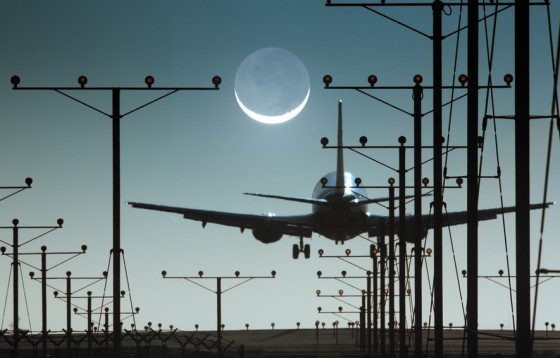
A simple change in operations gives aviation an environmental win-win-win.
Continuous Descent Arrival (CDA) is an aircraft operating technique in which arriving planes descend in a relatively straight line to the runway. In conventional descent, an aircraft drops in a stair-step manner, requesting control tower permission to descend to each new lower altitude, with portions of level flight in-between altitude changes.
CDA skips the stairs and takes the slide, aiming to avoid level flight to the extent permitted by safe operating procedures. The aircraft operates with minimal thrust, which significantly reduces power demand. In Europe, the procedure is called Continuous Descent Operation (CDO) and in the US it’s named Optimized Profile Descent (OPD).
By allowing arriving aircraft to maintain their high cruising altitude for longer periods before starting a continuous descent to the runway, CDAs nearly absolves the three environmental sins of aviation: fuel burn, emissions and noise. Keeping aircraft as high as possible for as long as possible is a very effective method of reducing noise impact on the ground.
Aircraft on a CDA flight path will begin a final descent from an altitude near 4,000 feet and a distance of about 12 nautical miles from final touch-down. They’ll maintain a steady descent angle of 3°+/- during approach.
Since aircraft approach speeds vary widely, CDAs require longer intervals between arriving flights, so they’re usually conducted in low traffic conditions, and typically at night. CDAs are not possible for all arriving flights and often not for the whole descent profile, but the technique is quickly being adopted at more airports and for an increasing number of flights.
For many airports, the opportunity to implement CDA is limited by high volume of air traffic. When approaching traffic is heavy, a pilot may need to adjust throttles, flap settings, and extend landing gear to maintain safe and consistent spacing with other aircraft in the terminal’s airspace, all of which requires the application of additional thrust to keep flying at the same speed.
Safety is paramount, and before CDA trials or operations commence, a rigorous safety assessment in undertaken.
At PAN-European level a Joint Industry CDA Action Plan has been adopted, which mapped out specific actions to be undertaken by the European aviation industry to ensure rapid and maximal deployment of CDA.
That plan seeks CDA roll-out at up to 100 European airports by the end of 2013; and CDA start-up at an additional 20 airports per year. Subsequently, the target’s been raised to at least 200 airports by end 2014, as industry support has been so strong.
CDA is now used at over 80 European airports.
Given the estimated 49,000 commercial airports worldwide, that statistic is a fly on an elephant’s bum. But CDA is growing exponentially, and the resultant savings in jet fuel is no drop in the bucket.
In the USA, the Federal Aviation Administration authorized development of arrival procedures to facilitate CDAs (again, known stateside as OPDs). While not as numerous as the European converts, the American airports coming aboard are among the nation’s Big Boys. Two OPD procedures were designed and successfully instituted at Los Angeles International Airport, and procedures have been extensively evaluated at Louisville-Standiford International Airport. Trials were also completed at Hartsfield-Jackson Atlanta International Airport and Miami International Airport.
Estimated fuel savings for CDA in Europe will potentially cut 150,000 tons of fuel per year, with associated savings around $123 million. Those same flights will reduce ground level noise impact in the range of 1-5 dB per flight, and cut CO2 emissions by almost 500,000 tons annually.
Environmental restrictions are in place at most European and American airports. The rapid deployment of CDA, even on a limited basis (as in limited hours of operation and height of descent commencement), provides airlines and airports with positive “currency” to offset other negative environmental impacts inherent in this industry.
CDA practices deliver major environmental and economic benefits. Adverse safety affects are mitigated by changes to the airspace architecture and now widespread availability of navigational support tools for air traffic controllers. An extending pool of CDA experience is accelerating system improvements: new airports can tap into “lessons learned” from around the world as they seek to develop their own protocols.
Currently, Middle Eastern airports lack an overarching aviation authority with jurisdiction over regional airspace, so adoption of continuous descent operations is left to specific countries and civil aviation agencies. As existing airports in this region balloon, and new ones come online, perhaps the MENA nations and Gulf Cooperation Council will give serious consideration to CDAs as they seek to standardize industry and regulations in the Arab region.
Image of plane landing from Shutterstock



